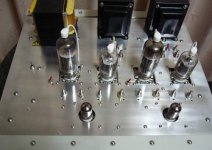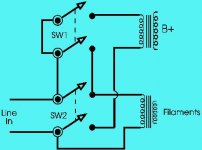Dear Kevin: I believe I didn't speak specifically of politic, instead I'm referring to facts of our reality. Politics' and their decisions influence all orders of our lives. Including the things related to audio and music. Even so, if you want to erase, my post, simply do it. No problem for me.
Osvaldo.
Osvaldo.
Last edited:
Dear Kevin: I believe I didn't speak specifically of politic, instead I'm referring to facts of our reality. Politics' and their decisions influence all orders of our lives. Including the things related to audio and music. Even so, if you want to erase, my post, simply do it. No problem for me.
Yes, politics and religion influence our life, but we don't discuss it here.
Once, I believe I'm not discussing nothing, only narrating a fact of the reality. So real as that 2 + 2 is 4.
Here, in Argentina, it is very difficult to buy some electronic (and much other) materials😡, by a politic decision. I don't tell nothing if it is good or not. Only a fact.
Sorry to all other members of the forum.
Here, in Argentina, it is very difficult to buy some electronic (and much other) materials😡, by a politic decision. I don't tell nothing if it is good or not. Only a fact.
Sorry to all other members of the forum.
 Osvaldo, The reason for the rule on politics and religion (among others) is because these topics tend to bring about very polar views which in the past have lead to lot's of unpleasentness.
Osvaldo, The reason for the rule on politics and religion (among others) is because these topics tend to bring about very polar views which in the past have lead to lot's of unpleasentness. You are free to discuss the difficulties in obtaining parts, the throw away society we live in today etc, just leave the political comments out and you will be fine.
Tony.
Reading the old Radiotron handbook, which I think can be downloaded, they have quite a lot on the subject of when to turn on the B+ and what should happen in "standby". More than I wanted to know! There are even times when a partial voltage should be applied in preference to zero or full. There are other times when it's best to just shut everything off. Every old Dynaco and other tube thing I used to own had but a single power switch. Most every tube guitar amp has two switches, one for power and one for standby.
Most every tube guitar amp has two switches, one for power and one for standby.
The rumor is, first standby switch was added because electroytics could explode without load and sag. Then guitarists liked them because they could switch off the sound before unplugging the guitar leaving the stage, but coming back they could switch it on immediately and start playing.
Hi!
Wire the two switches such that the filament switch not only switches the filament transformers, but also applies the mains voltage to the HV switch. This avoids that the HV can be accidentally switched on without filament voltage.
Best regards
Thomas

like this .
PL519 + 6JM6 PSE
meanwhile amplifier could switching to PL519 or 6JM6 operation standalone.
Member
Joined 2009
Paid Member
I found this somewhere:
"If you want to do 2 switches, I recommend you use 2 double-pole switches.
Wire a pole from each in series to feed the B+ power.
Wire a pole from each in parallel to feed the heaters.
No matter which order you hit the switches, one switch on gives you heater power, and the B+ comes on when both switches are on. There is no combination that gives you B+ without heaters on."
"If you want to do 2 switches, I recommend you use 2 double-pole switches.
Wire a pole from each in series to feed the B+ power.
Wire a pole from each in parallel to feed the heaters.
No matter which order you hit the switches, one switch on gives you heater power, and the B+ comes on when both switches are on. There is no combination that gives you B+ without heaters on."
If you go half way down this web page you will find a diagram for a dual DPDT solution.
Audio ratbag: Tube Taster Linestage
You might get a laugh along the way.
ray
Audio ratbag: Tube Taster Linestage
You might get a laugh along the way.
ray
When using real tube rectifiers (3B28 and such) I delay the HV for 30sec and then I have a resistor in series with caps that is shorted about 30sec after HV.
So, use a double timer in series to make sure the rectifiers only get HV when hot and that the start is always smooth.
With the rest of the rectifiers, just find one slow enough for the circuit you're using
So, use a double timer in series to make sure the rectifiers only get HV when hot and that the start is always smooth.
With the rest of the rectifiers, just find one slow enough for the circuit you're using
One project I did was set up with separate heater and HV supplies. I designed it that way since it used SS for the HV DC, and the circuit incorporated DC coupling between stages (ist preamp to LTP phase splitter/2nd pre and cathode follower grid drivers to the finals). This way, the heaters could be warmed up before the HV is switched on so that Vhk ratings aren't exceeded when the HV appears while cathodes are still cold.
In that case, the HV is interrupted if the heaters aren't switched on first. No heater power, no HV. This system worked out just great, and the amp has not failed in almost daily use since 2005.
A different project used a multi-secondary PTX (6.3V @ 5.0A; 5.0V @ 3.0A; 650Vct @ 150mA) with a 5U4GB for the HV. (Needed 350Vdc, and the PTX overvolted badly with SS diodes -- it looks like it was designed (NOS) to provide ~350Vdc when used with 5U4GBs, as that's what the plate characteristic predicted, and what I got once the PS was built.) With this project, there is just the one power switch that powers up everything: heaters and HV DC. Again, no problems with this design, as the HV DC is delayed anyway.
In that case, the HV is interrupted if the heaters aren't switched on first. No heater power, no HV. This system worked out just great, and the amp has not failed in almost daily use since 2005.
A different project used a multi-secondary PTX (6.3V @ 5.0A; 5.0V @ 3.0A; 650Vct @ 150mA) with a 5U4GB for the HV. (Needed 350Vdc, and the PTX overvolted badly with SS diodes -- it looks like it was designed (NOS) to provide ~350Vdc when used with 5U4GBs, as that's what the plate characteristic predicted, and what I got once the PS was built.) With this project, there is just the one power switch that powers up everything: heaters and HV DC. Again, no problems with this design, as the HV DC is delayed anyway.
- Status
- Not open for further replies.
- Home
- Amplifiers
- Tubes / Valves
- Separate Filament and B+ Switches
